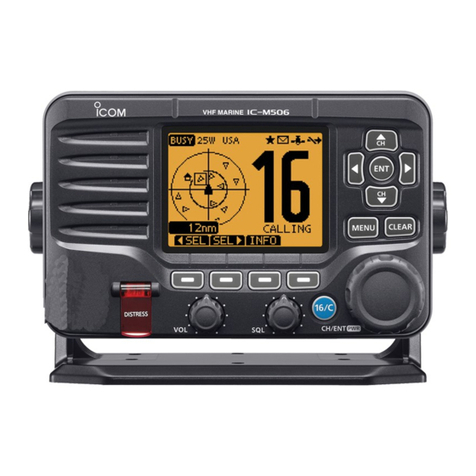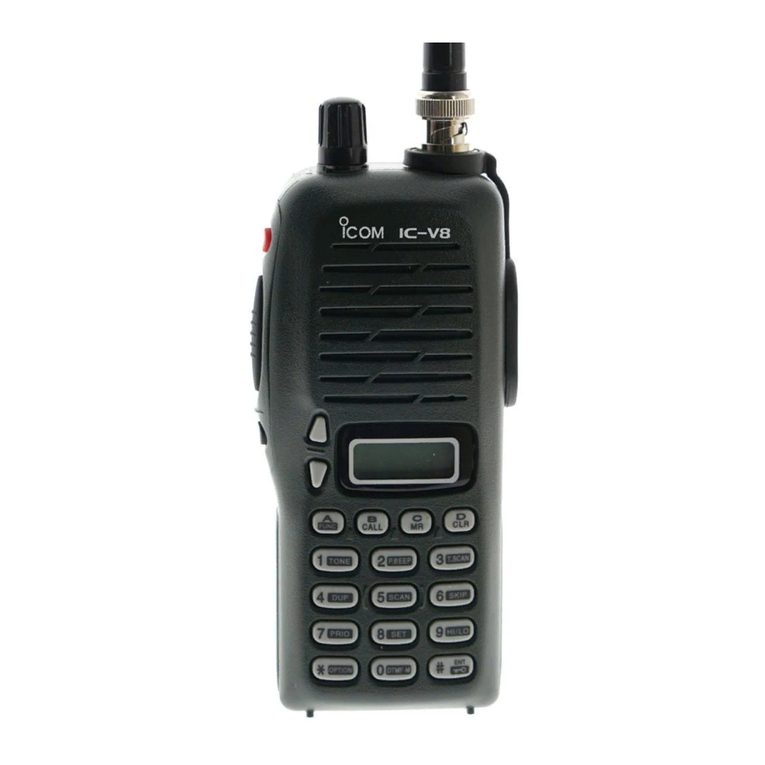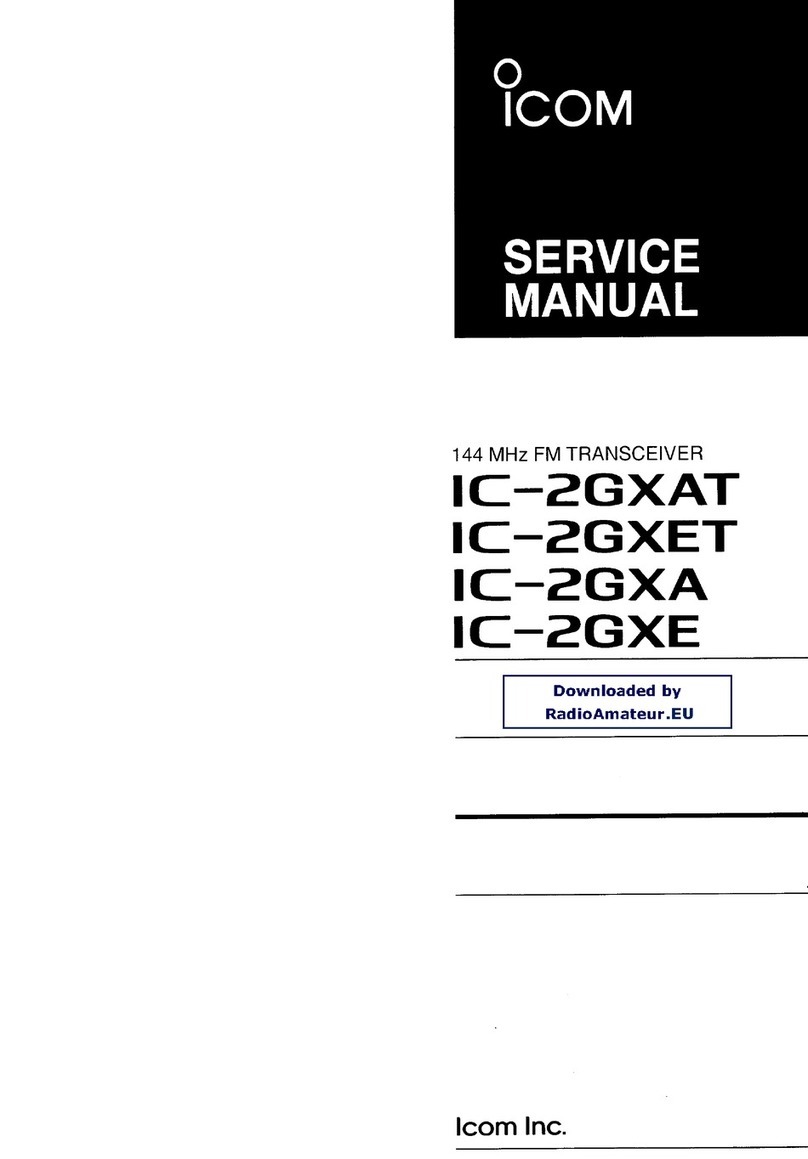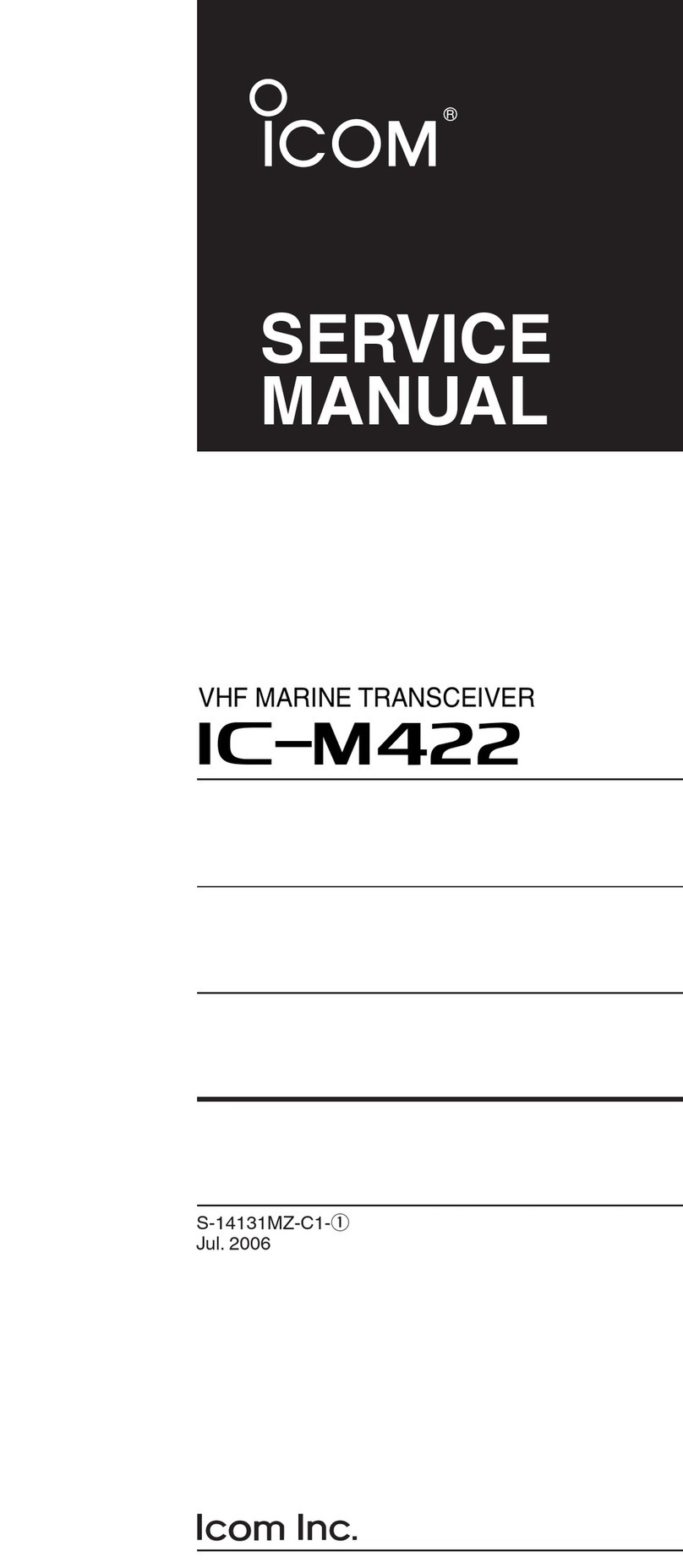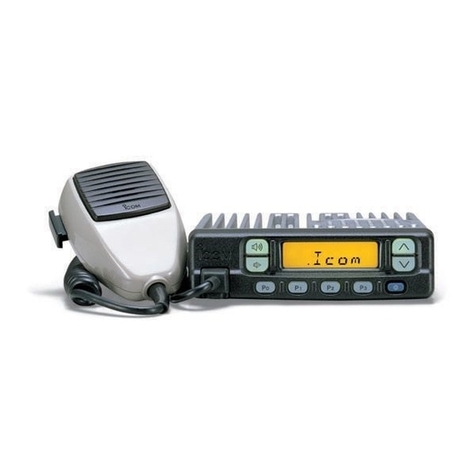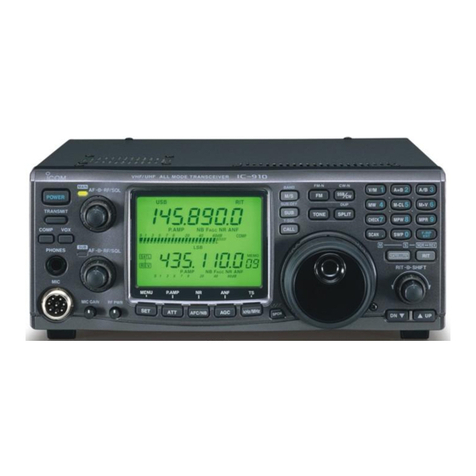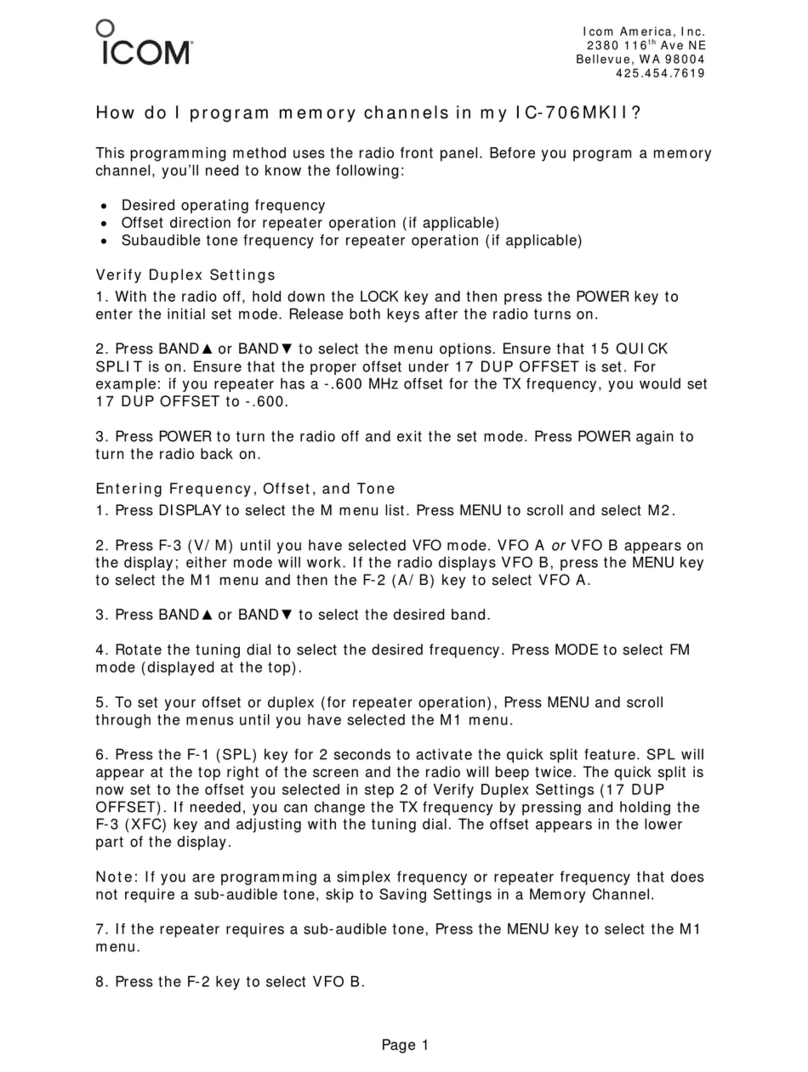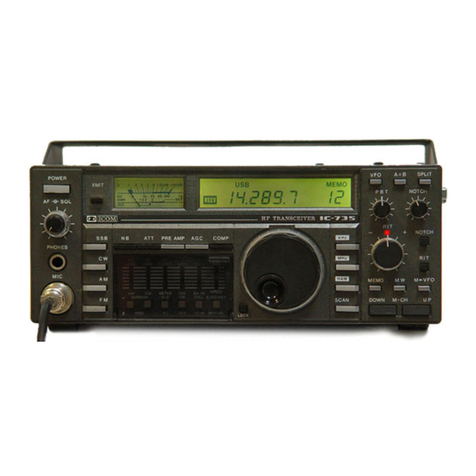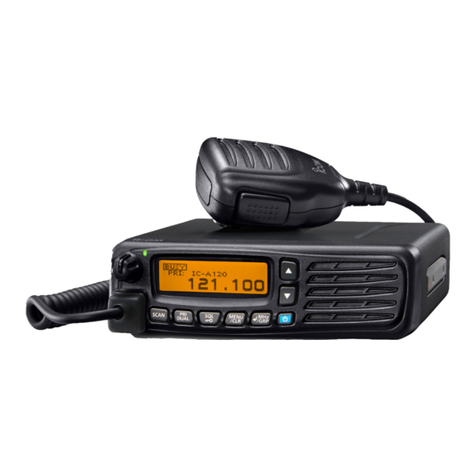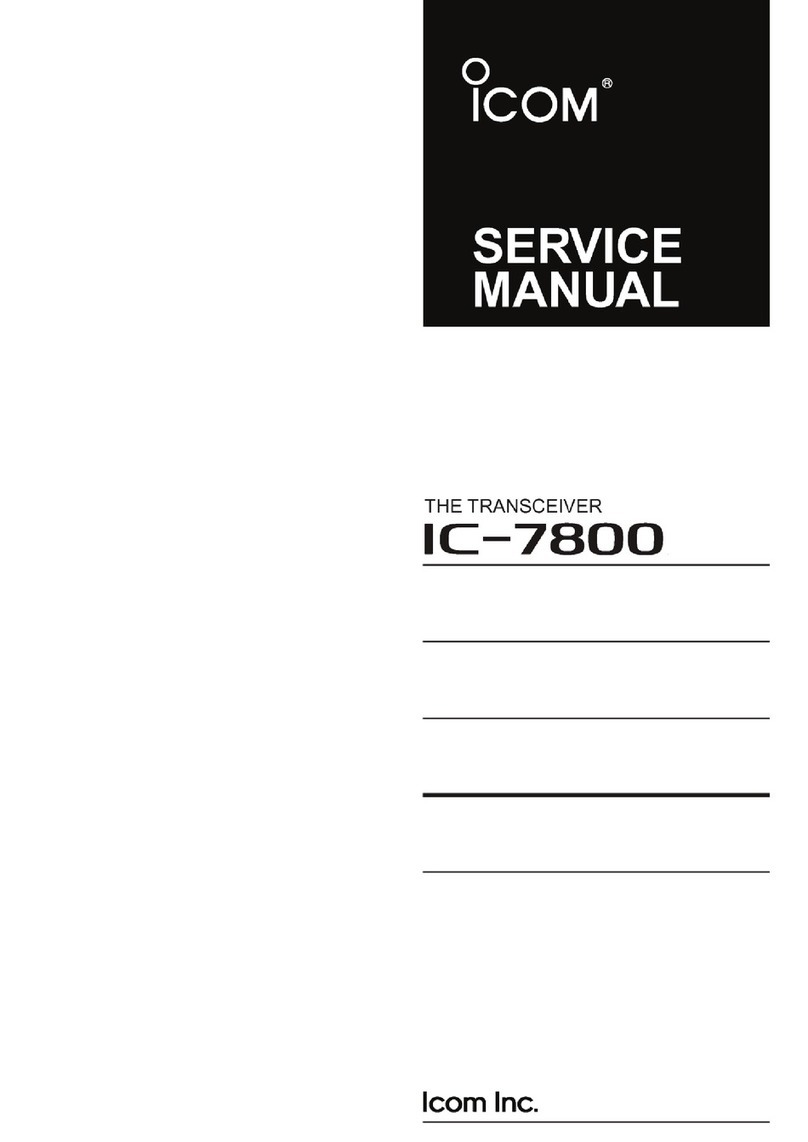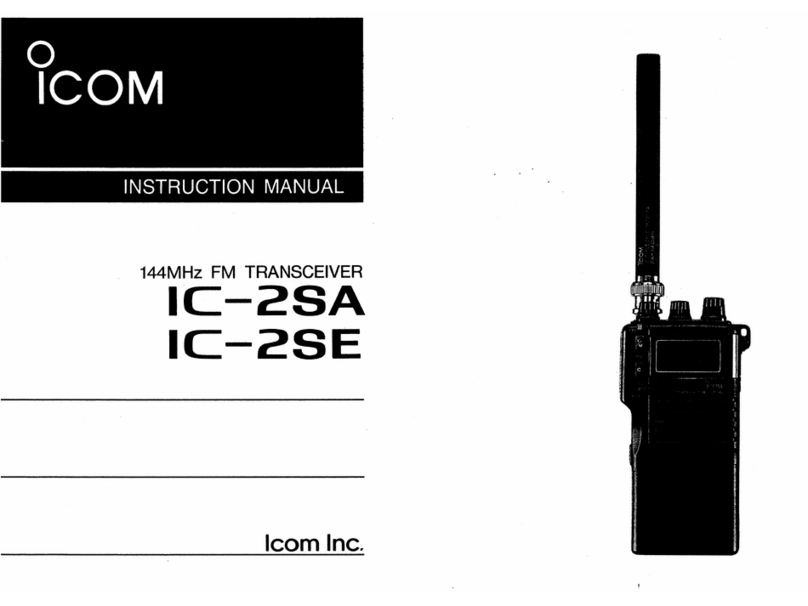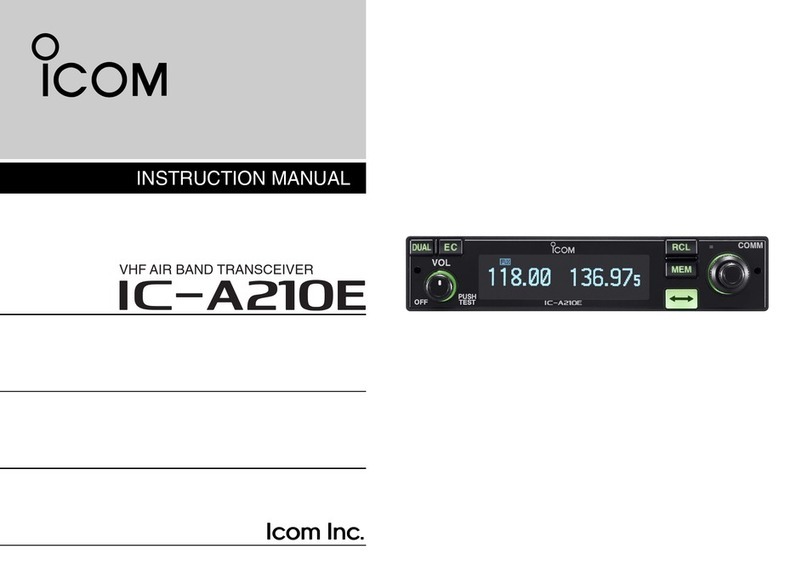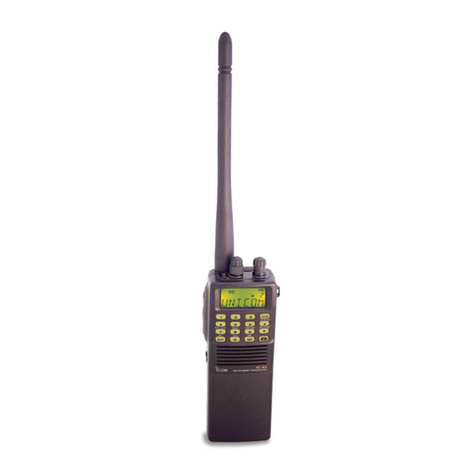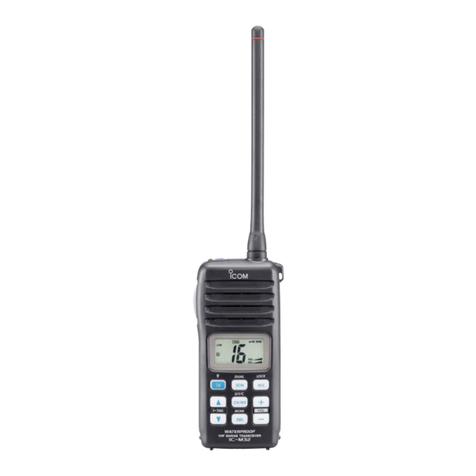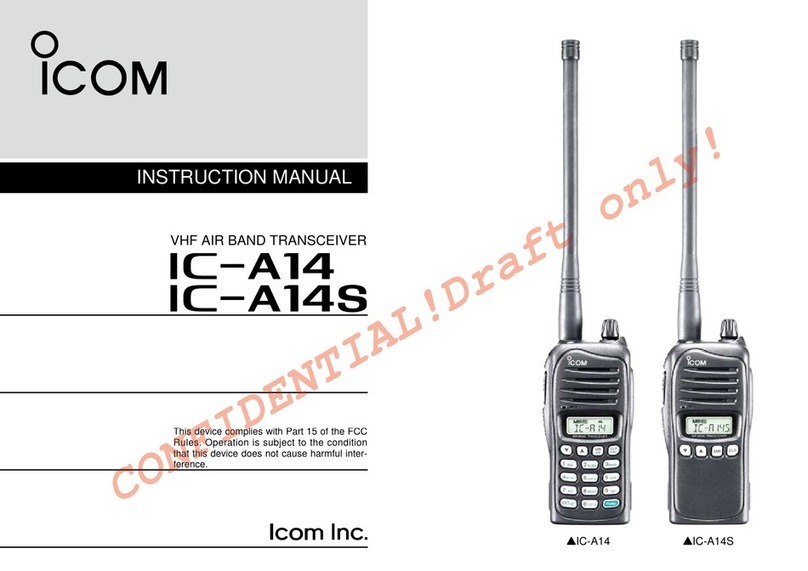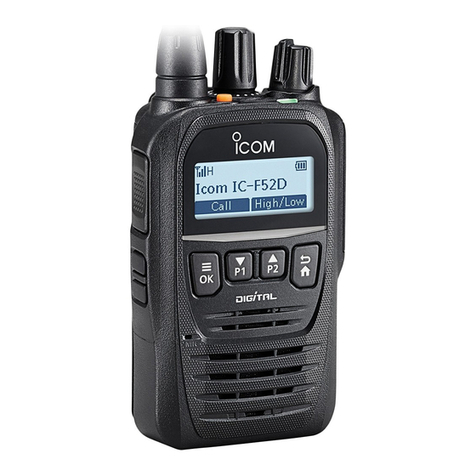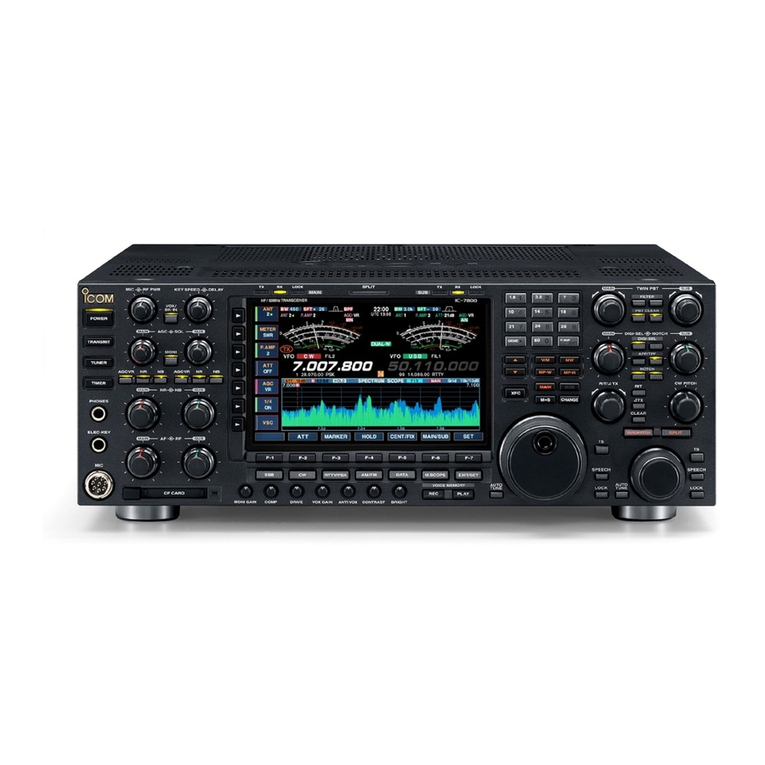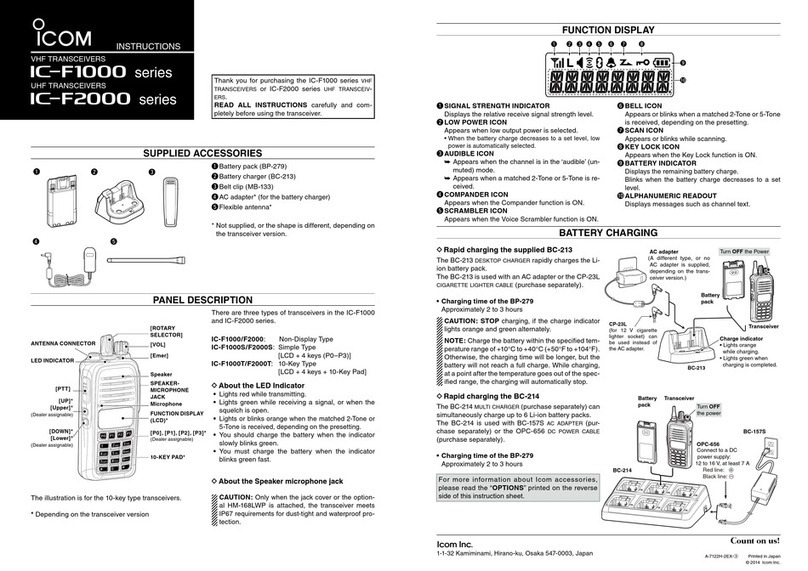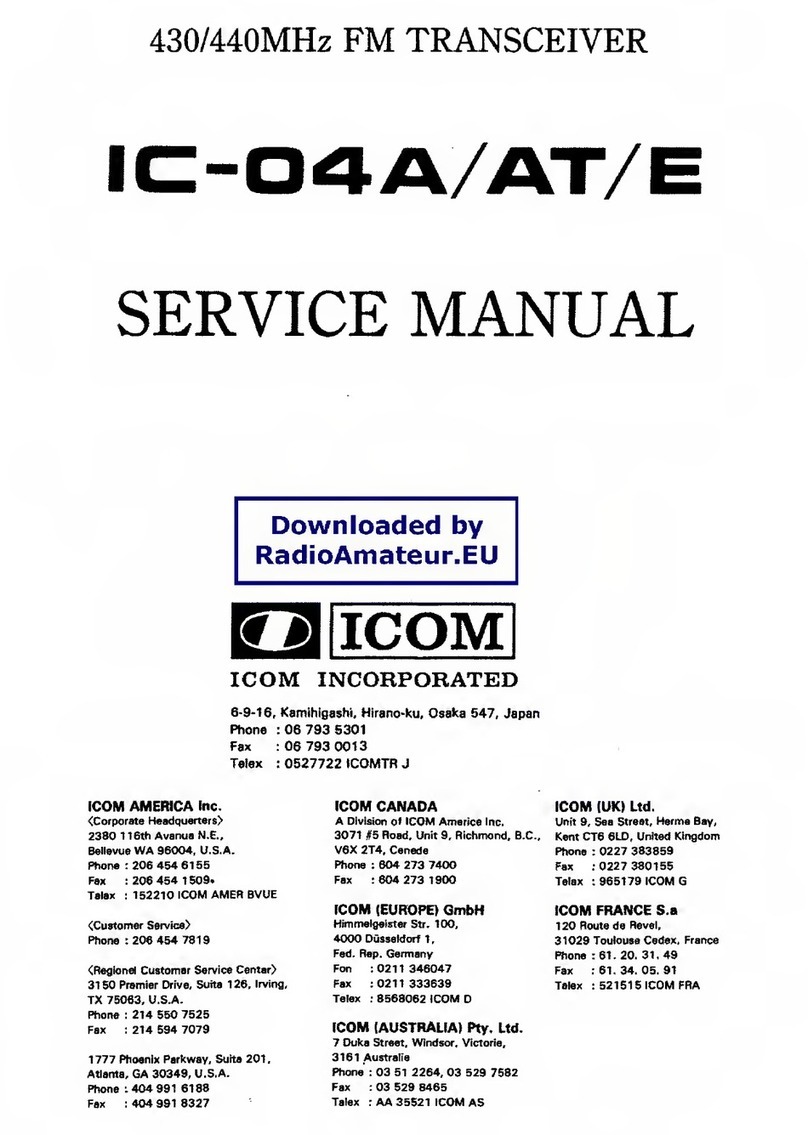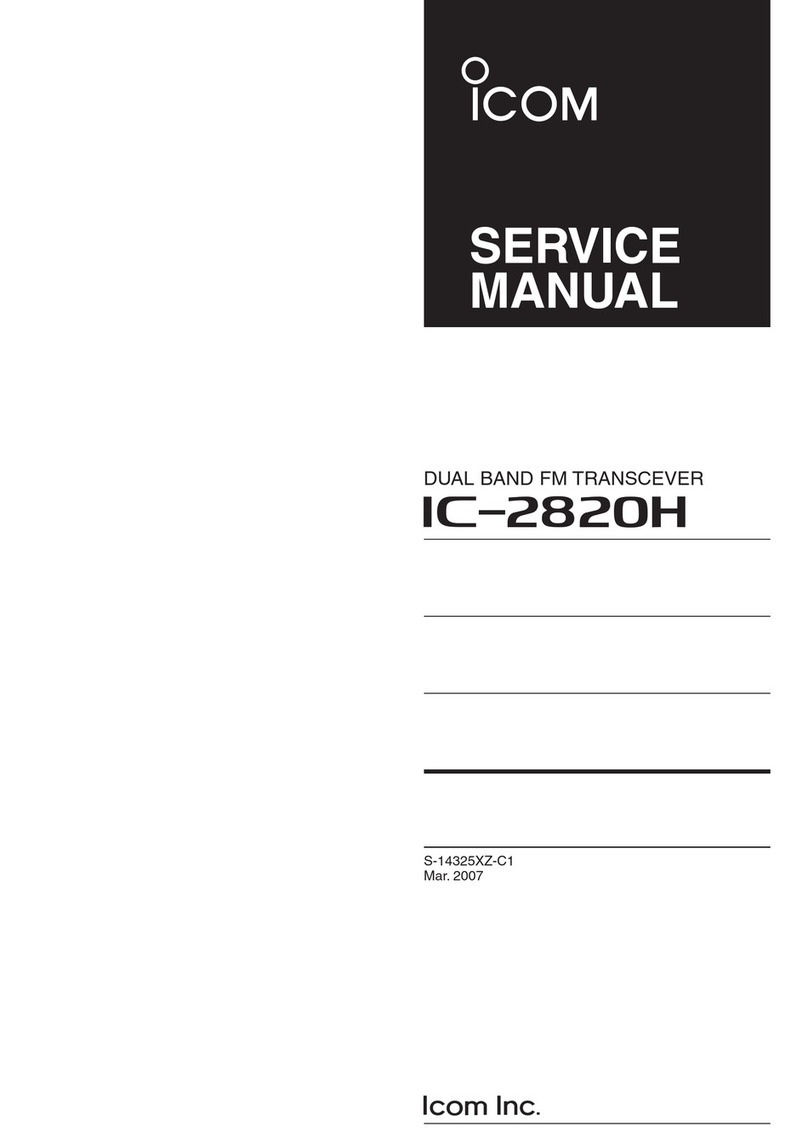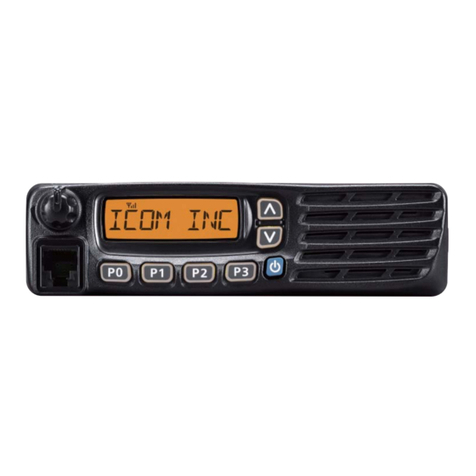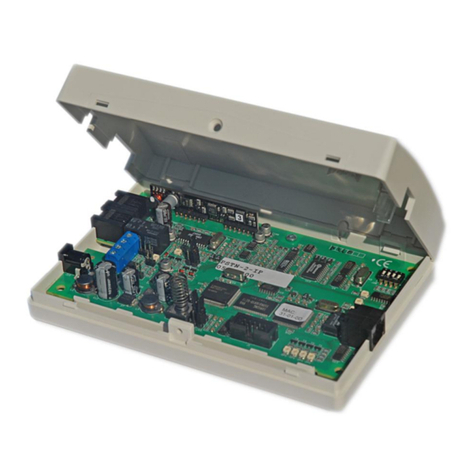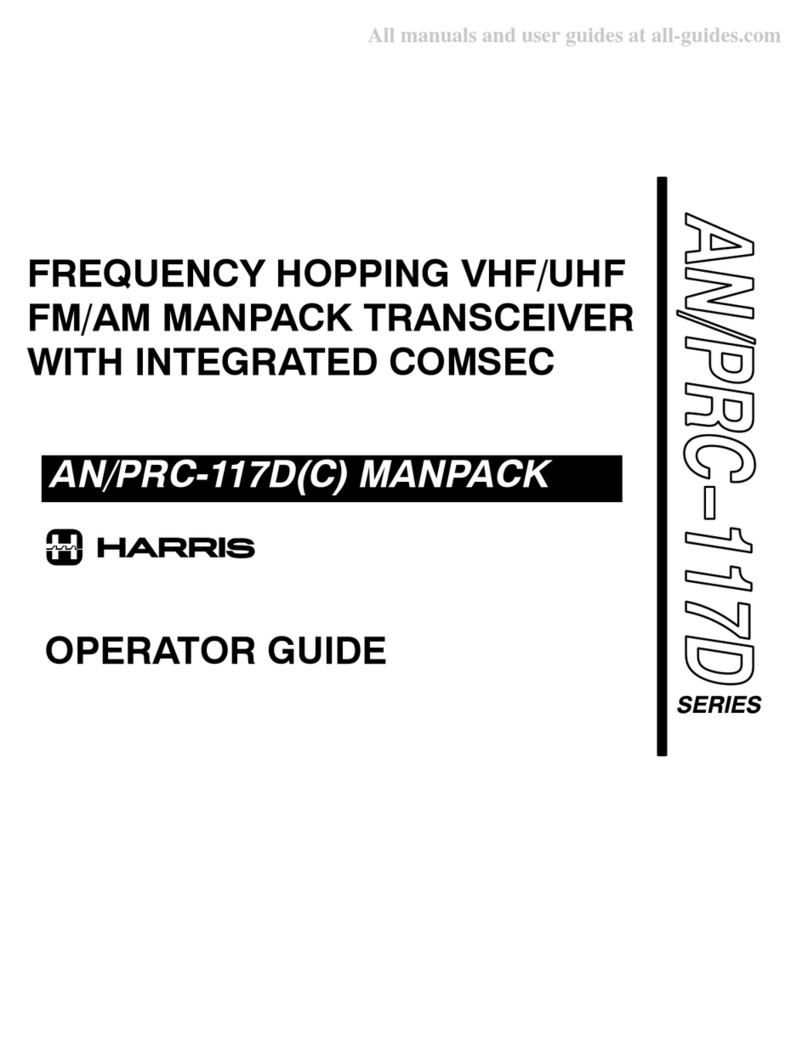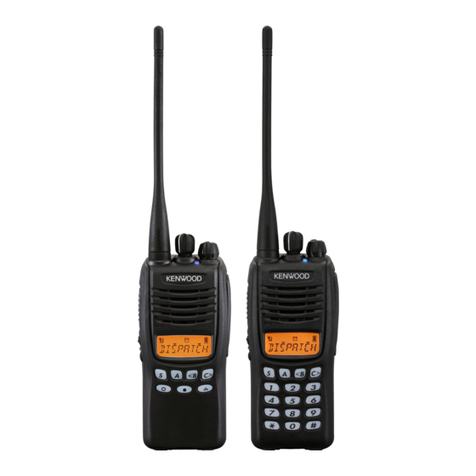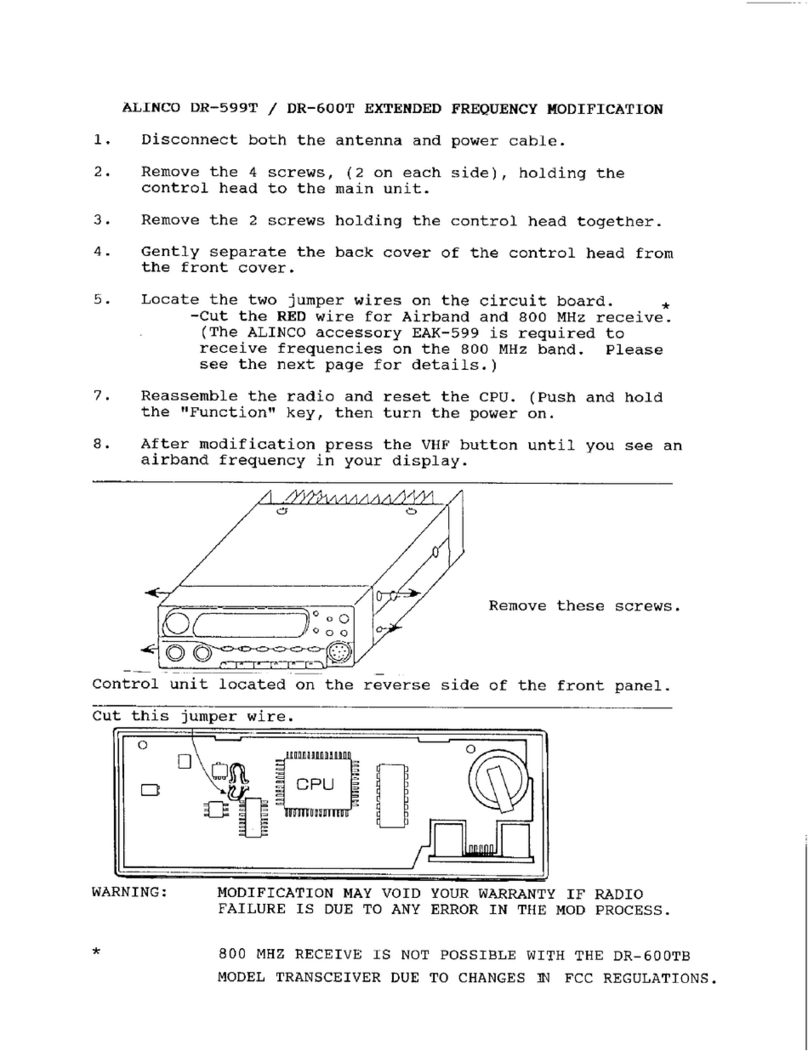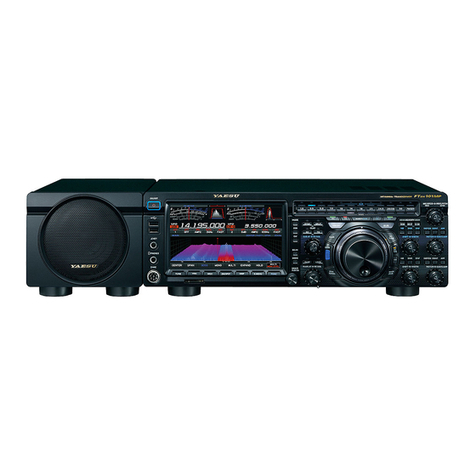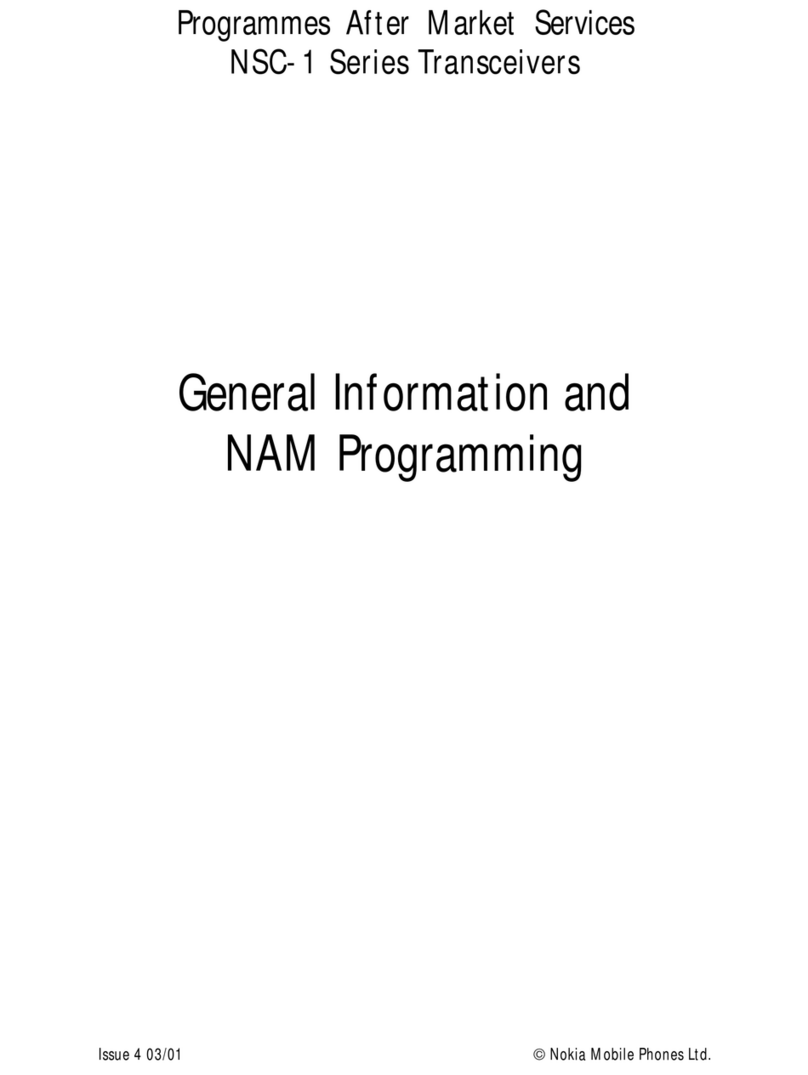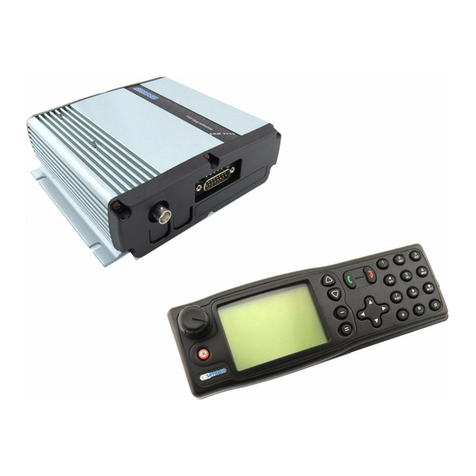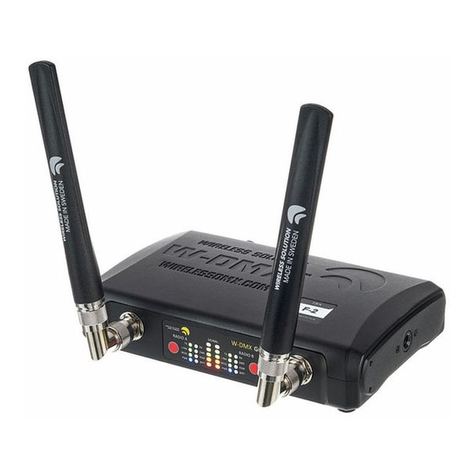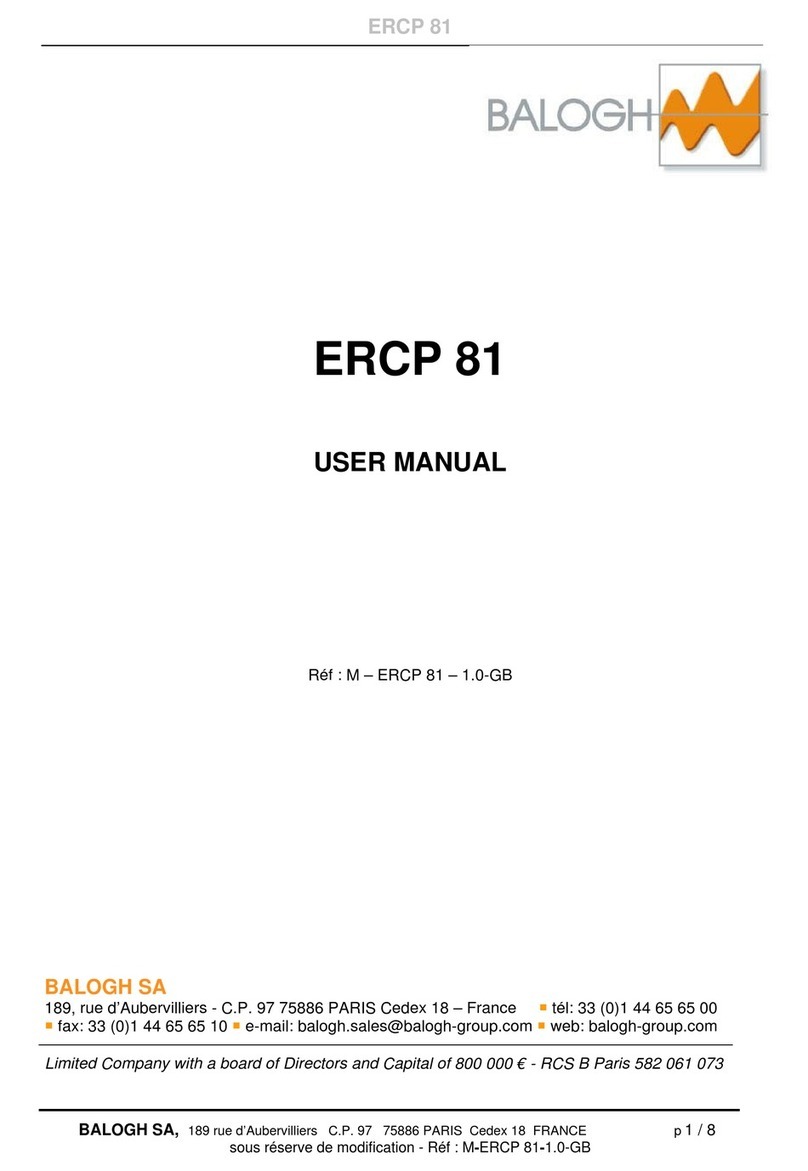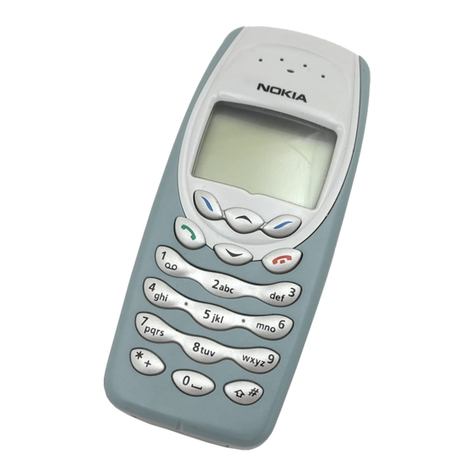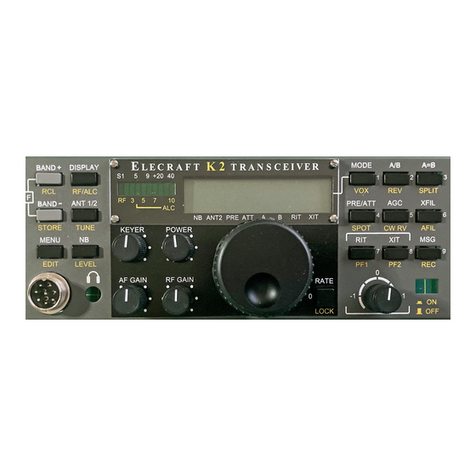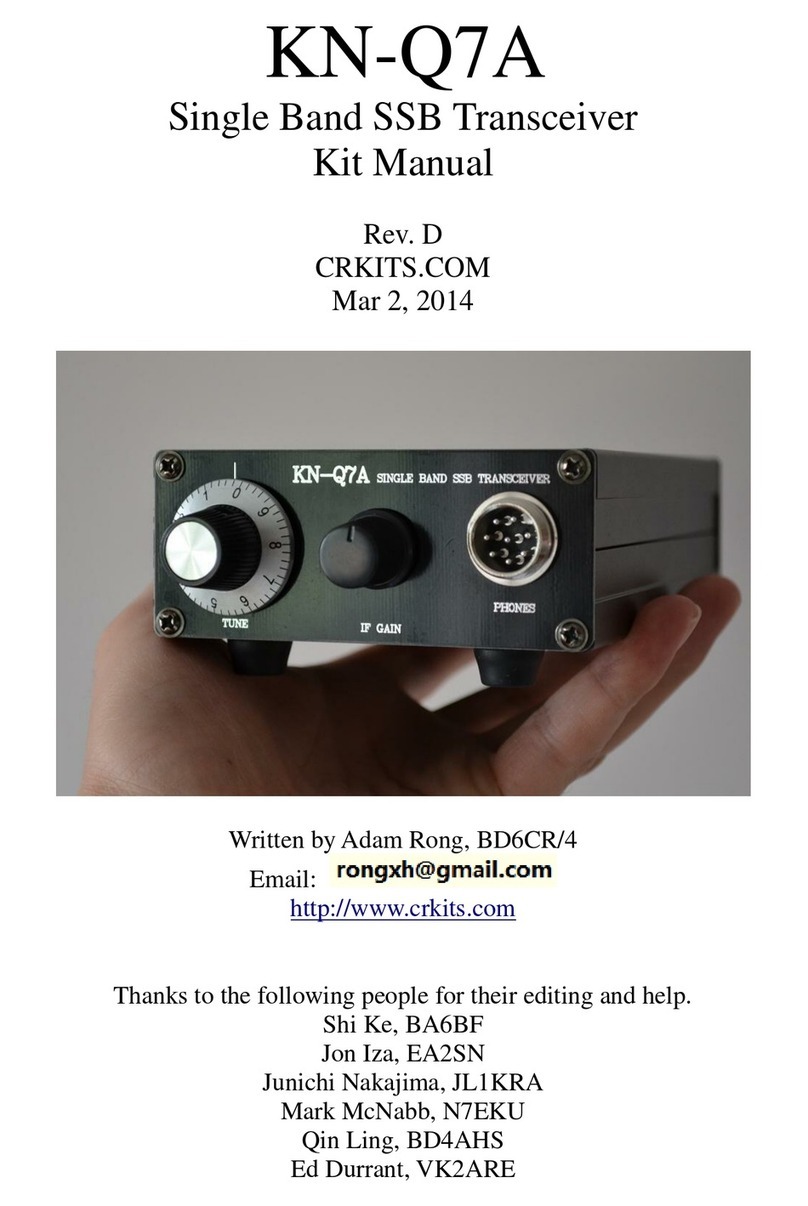Icom IC-A23 User manual

iA23
iA5
VHF AIR BAND TRANSCEIVER
INSTRUCTION MANUAL
This device complies with Part 15 of the FCC rules.Operation is sub-
ject to the following two conditions: (1) This device may not cause
harmful interference, and (2) this device must accept any interference
received, including interference that may cause undesired operation.

i
FOREWORD
READ ALL INSTRUCTIONS carefully and completely
before using the transceiver.
SAVE THIS INSTRUCTION MANUAL—This in-
struction manual contains important operating instructions for
the IC-A23/A5.
EXPLICIT DEFINITIONS
The explicit definitions below apply to this instruction manual.
CAUTION
RWARNING! NEVER hold the transceiver so that the
antenna is very close to, or touching exposed parts of the
body, especially the face or eyes, while transmitting. The
transceiver will perform best if the microphone is 5 to 10 cm
away from the lips and the transceiver is vertical.
RWARNING! NEVER operate the transceiver with a
headset or other audio accessories at high volume levels.
Hearing experts advise against continuous high volume op-
eration. If you experience a ringing in your ears, reduce the
volume level or discontinue use.
NEVER connect the transceiver to an AC outlet or to a
power source of more than 14 V DC. Such a connection will
damage the transceiver.
NEVER connect the transceiver to a power source that is
DC fused at more than 5 A. Accidental reverse connection will
be protected by this fuse, higher fuse values will not give any
protection against such accidents and the transceiver will be
ruined.
NEVER short the terminals of the battery pack. Also, cur-
rent may flow into nearby metal objects, such as a necklace,
WORD DEFINITION
RWARNING Personal injury, fire hazard or electric shock
may occur.
CAUTION Equipment damage may occur.
NOTE Inconvenience only. No risk of personal
injury, fire or electric shock.
FCC caution: Changes or modifications to this transceiver, not
expressly approved by Icom Inc., could void your authority to
operate this transceiver under FCC regulations. (U.S.A. only)

ii
etc.Therefore, be careful when carrying with, or placing near
metal objects, carrying in handbags, etc.
DO NOT allow children to play with any radio equipment
containing a transmitter.
DO NOT operate the transceiver near unshielded electrical
blasting caps or in an explosive atmosphere.
AVOID using or placing the transceiver in direct sunlight or
in areas with temperatures below –10°C (+14°F) or above
+60°C (+140°F).
The use of non-Icom battery packs/chargers may impair
transceiver performance and invalidate the warranty.
Even when the transceiver power is OFF, a slight current still
flows in the circuits. Remove the battery pack or case from
the transceiver when not using it for a long time. Otherwise,
the battery pack or installed dry cell batteries will become ex-
hausted.
SUPPLIED ACCESSORIES
Accessories included with the transceiver: Qty.
qAntenna........................................................................... 1
wBelt clip............................................................................ 1
eHandstrap........................................................................ 1
rBattery pack (BP-200L)*.................................................. 1
tWall charger* .................................................................. 1
•Carrying case (LC-147)* ............................................... 1
•HEADSET ADAPTER (OPC-967)* ............................... 1
*The battery pack, wall charger, HEADSET ADAPTER or carry-
ing case may differ depending on version. Some versions do not
include a battery pack, wall charger, HEADSET ADAPTER or
carrying case.
qw
e
t
r

FOREWORD .................................................................................... i
EXPLICIT DEFINITIONS ................................................................. i
CAUTIONS ....................................................................................... i
SUPPLIED ACCESSORIES............................................................. ii
TABLE OF CONTENTS .................................................................. iii
1 ACCESSORY ATTACHMENT .................................................. 1
2 PANEL DESCRIPTION ........................................................ 2–7
■Panel description ............................................................... 2–5
■Function display ................................................................ 6–7
3 BASIC OPERATION .......................................................... 8 –11
■DIAL↔[Y]/[Z] trade function...................................................8
■Setting a frequency ................................................................ 8
■Accessing 121.5 MHz emergency frequency ......................... 8
■Selecting a weather channel................................................... 9
■Setting a squelch level ........................................................... 9
■Side tone function .................................................................. 9
■Beep tone ............................................................................... 9
■Lock function ........................................................................ 10
■Display backlighting ............................................................. 10
■Low battery indicator ............................................................ 10
■REC/PLY of recorded signals/messages ............................. 10
■Receiving ............................................................................. 11
■Transmitting .......................................................................... 11
4 MEMORY OPERATION ................................................... 12 –15
■Memory channel selection ................................................... 12
■Transferring memory contents ............................................. 12
■Programming a memory channel ......................................... 13
■Memory names ............................................................. 14 –15
5 SCAN OPERATION ......................................................... 16– 17
■Scan types ........................................................................... 16
■COM band scan ................................................................... 16
■Memory scan ....................................................................... 16
■Weather channel scan ......................................................... 17
■“TAG” channels ................................................................... 17
6 VOR NAVIGATION (IC-A23 only).................................... 18– 24
■VOR indications ................................................................... 18
■VOR functions ...................................................................... 19
■Flying to a VOR station ................................................. 20 –21
■Entering a desired course .................................................... 22
■Crosschecking position ................................................. 22 –23
■Duplex operation ................................................................. 24
7 BATTERY PACKS ........................................................... 25– 27
■Charging precautions ........................................................... 25
■Battery pack charging ................................................... 25 –26
■About the battery pack ......................................................... 27
■Battery pack CAUTION ........................................................ 27
8 CLONING ................................................................................ 28
9 TROUBLESHOOTING ............................................................ 29
10 SPECIFICATIONS .................................................................. 30
11 OPTIONS ......................................................................... 31 –32
(■OPC-967 connection ......................................................... 32)
12 OPERATION GUIDE ....................................................... 33 –34
iii
TABLE OF CONTENTS

1
1
ACCESSORY ATTACHMENT
DAntenna
CAUTION: Transmitting without an antenna may damage
the transceiver.
Insert the supplied antenna into the antenna connector and
screw down the antenna as shown below.
Keep the jack cover attached when jacks are not in use to
avoid bad contacts from dust and moisture.
DBelt clip
Conveniently attaches to your belt.
To attach:
Slide the belt clip into the plastic loop on the back of the bat-
tery case/pack.
To remove:
Push the top of the belt clip towards the transceiver and at
the same time, push it downward and free of the plastic loop.

2
2PANEL DESCRIPTION
■Panel description
e[DIAL]
r[MIC/SP]
w[PTT]
t[ANT]
!0[CLR(DIAL/ÙÚ)]
!1[ANL(REC)]
!2[BANK(PLAY)]
!3[FUNCTION]
!4[MR(MW)]
!5[ENT(WX)]
q[LIGHT]
yDisplay
u[UP/DOWN]
i[SQL(SCAN)]
Tx/Rx
indicator
!6[DIGITKEYS]
o[PWR]
u
i
!0
!1
!2
!3
!4
!5
o
!6

3
2
PANEL DESCRIPTION
qLIGHT [LIGHT] (p. 10)
Turns the light for display and keypad ON or OFF.
wPTT SWITCH [PTT] (p. 11)
Push and hold to transmit; release to receive.
eTUNING DIAL [DIAL] (p. 8)
➥Rotate [DIAL] to select the desired frequency. (default)
➥Rotate [DIAL] to select the BANK number. (default)
➥Rotate [DIAL] to select the memory channel or WX
channel number. (default)
➥Rotate [DIAL] to adjust the audio level.
rEXTERNAL SPEAKER AND MICROPHONE JACKS
[MIC/SP]
Connect an OPC-967 HEADSET ADAPTER or headset, if
desired.
tANTENNA CONNECTOR [ANT]
Connects the supplied antenna.
yFUNCTION DISPLAY (pgs. 6, 7)
uUP/DOWN KEYS [Y]/[Z] (p. 8)
➥Push [Y] to increase the audio level, push [Z] to
decrease the audio level.(default)
➥Push to select the operating channel or fre-
quency.
➥Push to select the BANK number.
iSQUELCH KEY [SQL (SCAN)] (p. 9)
➥Push [SQL], then rotate the [DIAL] (or push
[Y]/[Z]) to select the squelch level.
•24 squelch levels and squelch open (0) are available.
➥Push , then push [SQL] to starts scan func-
tion:
Frequency mode: Frequency scan function.
MEMORY mode: Bank scan or Full memory chan-
nel scan function.
oPOWER SWITCH [PWR]
➥Push and hold for 0.5 sec. to turn the power ON
or OFF.
➥While pushing and holding [Y]/[Z] key, push
[PWR] to enter the cloning function mode.(OPC-
967 must be connected.)
!0 CLR KEY [CLR (DIAL/YZ)] (p. 8)
➥Push , then push [CLR] to exchange the e
tuning Dial function and uUP [Y]/DOWN [Z]
switch function;
- Dial: tuning (default)
- UP[Y]/DOWN[Z]: audio level setting (default)
NOTE: You can adjust the audio level via [DIAL]
and select the frequency, memory channel or
BANK number via UP[Y]/DOWN[Z] keys.
➥Push [CLR] to turn to the frequency mode, when
memory channel, WX channel or 121.5 MHz is
selected.

4
2PANEL DESCRIPTION
!0 CLR KEY [CLR(DIAL/YZ)](continue)
➥Push [CLR] to cancel the SCAN function.
➥Push [CLR] to cancel the direct frequency enter-
ing with digit key.
➥Push [CLR] to turn the squelch level adjusting
mode OFF.
!1 ANL KEY [ANL (REC)]
➥Push to turn the ANL function ON or OFF.
➥Push , then push [ANL (REC)] to turn the
recording function ON. (p. 10)
- The transceiver records the receiving signal or opera-
tors voice message by push and holding [PTT] for 20
sec.
!2 BANK KEY [BANK (PLAY)]
➥Push [BANK] to enter the BANK selection mode
while memory channel is selected, push [CLR]
to exit the BANK selection mode.(p. 12)
➥Push , then push [BANK] to play the
recorded signals. (p. 10)
!3 FUNCTION KEY [F]
Push to call up the function indicator, “”, then
push another key to access its secondary function.
•“ ”appears for 3 sec. after [F] is pushed; at this time
pushing [F] again cancels the indication. (p. 6)
NOTE: In general, “”disappears when another key is
pushed to activate a secondary function. However, some
keys which have more than one secondary function, (such
as [DUP]), do not cancel “”.In this case, “”disappears
automatically after 3 sec.
!4 MEMORY MODE KEY [MR (MW)] (pgs. 12, 13)
➥Push [MR] to call the memory channel mode,
push [CLR] to exit the memory channel mode.
➥Push , then push [MR (MW)] to program the
contents into the memory channels.
➥Push [MR] to program the memory comment
when the memory comment function is enabled.
!5 ENTER KEY [ENT(WX)]
➥Push [ENT] to enter the numeral input. Enters
consecutive zero digits. (p. 8)
➥Push , then push [ENT] to enter the weather
channel selection mode.(U.S.A. version only) (p.
9)
•Rx/Tx indicator
➥Lights red during the transmit mode.
➥Lights green during receiving a signal or squelch is
open.
NOTE: Some functions may not be available depending on
version.Please consult your dealer.

5
2
PANEL DESCRIPTION
!6 DIGIT KEYS
➥Input the specified digit during frequency input, memory
channel selection, etc.
➥In addition, each key has one or more secondary func-
tions after pushing as follows:
➥Push , then push [0 (121.5)] to select the
121.5 MHz emergency frequency. (p. 8)
➥Push , then push [1 (DVOR)] to select the
DVOR display from the CDI display in NAV band.
(p. 19)*1
➥Push , then push [2 (TO)] to change the
course indicator characteristics to “TO”flag in the
DVOR display in NAV band. (p.19)*1
➥Corrects the deviation while using “TO”flag. *1
➥Push , then push [3 (FROM)] to change the
course indicator characteristics to “FROM”flag
in the DVOR display in NAV band. (p.19)*1
➥Corrects the deviation while using “FROM”flag.
*1
➥Push , then push [4 (CDI)] to select the CDI
display from the CDI display in NAV band. (p.
19)*1
➥Push , then push [5 (DUP-W)] to set the du-
plex frequency in NAV band. (p. 22)*1
➥Push , then push [6 (DUP)] to turn the du-
plex function ON and OFF in NAV band. (p.
22)*1
➥Push , then push [7 (KEY LOCK)] to turn
the key lock function ON and OFF. (p.10)
➥Push , then push [8 (BEEP)] to turn the
beep tone adjusting mode ON.
•Adjustable level;0 to 9 (p. 9)
➥Push , then push [9 (TAG)] to set the dis-
played memory or weather channel as a “TAG”
channel. (p. 17)
*1These functions available on the IC-A23 only.

6
2PANEL DESCRIPTION
■Function display (COM)
qFUNCTION INDICATOR (p. 4)
Appears when is pushed.
wANL INDICATOR (p. 4)
Appears while the ANL (Automatic Noise Limiter) function
is in use.
eLOCK INDICATOR (p. 10)
➥Appears while the lock function is in use.
rDUPLEX INDICATOR (IC-A23 only) (p. 22)
➥“DUP”appears when the duplex function is activated in
NAV mode.
➥“DUP”blinks while setting the duplex frequency.
tLOW BATTERY INDICATOR (p. 10)
➥Appears when the battery is nearing exhaustion.The at-
tached battery pack requires recharging.
➥Appears and flashes when battery replacement is nec-
essary.
yRECORD INDICATOR (p. 10)
➥”REC”blinks while the internal recorder is recording the
signal.
uPLAY INDICATOR (p. 10)
➥“PLAY”appears during play back of the recorded signal.
iTAG CHANNEL INDICATOR (p. 17)
➥“TAG”appears when the memory channel is set as a
TAG channel.
oMEMORY CHANNEL INDICATOR (p. 12)
➥Shows the memory channel number.
yu
!1
t
!0
o
re
w
q
i

7
2
PANEL DESCRIPTION
!0 MEMORY BANK NUMBER INDICATOR (p. 12)
Shows the selected memory bank number.
!1 FREQUENCY DISPLAY (p. 8)
➥Shows the operating frequency.
➥Shows the channel name when the memory name func-
tion is selected.
!2 COURSE INDICATORS (IC-A23 only) (p. 19)
➥Indicates where your aircraft is located on a VOR radial
in DVOR mode.
➥Indicates where your desired course is located on a
VOR radial in CDI mode.
!3 TO-FROM INDICATOR (IC-A23 only) (p. 19)
➥Indicates whether the VOR navigation information is
based on a course leading to the VOR station or lead-
ing away from the VOR station.
!4 COURSE DEVIATION NEEDLES (IC-A23 only) (p.22)
➥Indicates the deviation between the desired course and
your actual flying course every 2 degrees.
!5 OVERFLOW INDICATOR (IC-A23 only) (p. 22)
➥Appears when the deviation between the desired course
and flying course is over 10 degrees.
!5
!4
!3!2
■Function display (COM/NAV)

8
3BASIC OPERATION
■DIAL↔[Y]/[Z] trade function
The transceiver is equipped [DIAL]↔[Y]/[Z] keys trade func-
tion. Push then push [CLR (DIAL/YZ)] to trade each
function.
Default setting:
DIAL: •Setting the frequency, •Selecting the memory chan-
nel, •Selecting the bank number
YZ keys:•Increasing or decreasing the audio level
Following explanation is according to the default setting.
■Setting a frequency
ïUsing keypad
qPush [PWR] for 0.5 sec. to turn power ON, then push
[CLR] to select the frequency mode when memory CH
number or WX CH number appears on the function display.
wPush 5 appropriate digit keys to input the frequency.
•Enter [1] as the 1st digit.
•When a digit is mistakenly input, push [CLR] to clear,
then start again.
•Push [ENT] to enter consecutive zero digits.
•Only [2], [5], [7] and [0] can be entered as the 5th and
final digit.
ïUsing the tuning dial
qPush [PWR] for 0.5 sec. to turn power ON, then push
[CLR] to select the VFO mode when memory CH number
or WX CH number appears on the function display.
wRotate the [DIAL] to set the desired frequency.
eTo select the 1 MHz tuning step, push , then rotate the
tuning dial. Push again to return the normal tuning.
■Accessing 121.5 MHz emer-
gency frequency
The IC-A23 and IC-A5 can quickly access the 121.5 MHz
emergency frequency. This function can be activated even
when the key lock function is in use.
qPush , then push [121.5] to call the emergency fre-
quency.
wPush [CLR] to exit from the emergency frequency.

■Selecting a weather channel
(U.S.A. version only)
The U.S.A. version has VHF marine WX (weather) channel
receiving capability for flight planning.
qPush ,then push
[ENT (WX)] to select WX
channel mode.
•“WX--”and previously se-
lected channel number ap-
pears.
wRotate the [DIAL] to select the desired WX channel.
ePush [CLR] to exit the WX channel mode and return to fre-
quency mode.
■Setting squelch level
The transceiver has a noise squelch circuit to mute undesired
noise while receiving no signal.
DSetting the squelch level
qPush [SQL], then rotate the [DIAL] (or using [Y]/[Z]key)
to select the squelch level.
•‘SQL--0’is loose squelch and ‘SQL--24’is tight squelch.
•Rx indicator turns to green during the squelch is open.
wPush [SQL] or [CLR] to exit the squelch set mode.
■Side tone function
When using an optional headset, such as those from the
David Clark Co. via the OPC-967 HEAD SET ADAPTOR, the
transceiver outputs your transmitted voice to the headset for
monitoring. (p. 32)
DSetting the side tone level
qPush [PTT] to turn the transmit mode ON.
wDuring transmit mode, push [Y]/[Z] several times to adjust
the monitoring level.
•‘ST--0’is OFF and ‘ST--15’is Max. level.
NEVER operate the transceiver with a headset at high vol-
ume levels for long period. A ringing in your ears may
occur. If so, reduce the monitor level or discontinue use.
■Beep tone
The beep tone which sounds each times a switch is pushed
can be adjusted, as desired.
qPush , then push [BEEP].
wRotate [DIAL] (or using [Y]/[Z] key) to adjust the beep
level.
ePush [CLR] to exit the beep tone set mode.
•‘BEP-0’is OFF and ‘BEP--9’is Max. level.
9
3
BASIC OPERATION

10
3BASIC OPERATION
■Lock function
The lock function prevents accidental frequency changes and
accidental function activation.
qPush , then push [KEY LOCK] to turn the function ON.
wTo turn the function OFF,repeat step qabove.
•“ ”disappears.
■Display backlighting
Push [LIGHT] to turn the display backlighting ON or OFF.
■Low battery indicator
Low battery indicator appears when the battery power has
decreased to a specified level.The attached battery pack re-
quires recharging.
■REC/PLAY the signals
/messages
DRecording a signal
/message
➥Push , then push [ANL
(REC)] to start to record the
message for 20 sec.
•‘REC’blinks on the display.
•Push [CLR] to cancel the recording.
•No message is recorded when no audio comes from the speaker.
(e.g.When the squelch is closed.)
•You can record your own message by pushing and holding [PTT]
during the recording mode. Frequency or memory CH display
disappears in this case.
•No transmission available during the recording mode.
•Only the latest message is remains.
DPlay
➥Push , then push
[BANK (PLAY)] to play back
the message.
•‘PLAY’appears on the dis-
play.
•Push [CLR] to cancel the
play back.
•Play back the message during the transmit mode, you can trans-
mit the recorded message.
then
then
Low battery
indicator

11
3
BASIC OPERATION
■Receiving
qPush [PWR] to turn the power ON.
wPush [SQL], then turn the [DIAL] counterclockwise (or [Z]
key) to select the squelch level [0].
ePush [Y]/[Z] key several times to adjust the audio level.
rPush [SQL], then turn the [DIAL] clockwise (or [Y]key)
until the noise is muted.
•The Tx/Rx indicator disappears.
tSet the desired frequency using the [DIAL] or keypad.
yPush [ANL] to reduce pulse noise such as that caused by
engine ignition systems, if necessary.
•[ANL] appears on the display.
uWhen a signal is received on the set frequency:
•The Tx/Rx indicator lights green
•Squelch opens and audio is emitted from the speaker.
When the [SQL] control is too “deep”, squelch may not open
for weak signals.To receive weak signals, set the squelch to a
“loose”position.
■Transmitting
qSet the desired frequency in COM band using the [DIAL]
or keypad.
•COM band frequency range: 118.00–136.975 MHz
wPush and hold [PTT] to transmit.
•The Tx/Rx indicator lights red.
eSpeak into the microphone at a normal voice level.
•DO NOT hold the transceiver too close to your mouth or
speak too loudly.This may distort the signal.
rRelease [PTT] to return to receive.
CAUTION: Transmitting without an antenna may damage
the transceiver.
NOTE: To prevent interference, listen on the frequency be-
fore transmitting. If the frequency is busy, wait until the
channel is clear.

12
4MEMORY OPERATION
■Memory channel selection
The transceiver has 200 memory channels for storage of
often-used frequencies along with 6-character notes.
qPush [MR] to select memory mode.
•Memory BANK number and memory CH number appears.
Using the [DIAL]:
wPush [BANK], then rotate the [DIAL] to select the desired
memory bank number, then push [BANK] (or [CLR]) to exit
the bank selection mode.
•“BANK”appears.
eRotate [DIAL] to select the desired memory CH number.
•If no memory channel is programmed in the selected bank, no
memory CH selection is available.
Using the Keypad:
wPush [BANK], then push appropriate digit key (0 to 9) to
select the desired memory bank number, then push
[BANK] (or [CLR]) to exit the bank-selection mode.
•“BANK”appears.
ePush 2 appropriate digit key (00 to 19) to select the de-
sired memory CH number.
•If no memory channel is programmed in the selected bank, no
memory CH selection is available.
Comments appear first when programmed, however, the
transceiver can be programmed by your dealer to show
the operating frequency first. Push [MR] to display the
comment in this case.
■Transferring memory
contents
This function transfers a memory channel’s contents into the
frequency mode. This is useful when searching for signals
around a memory channel’s frequency.
qPush [MR] to select memory mode.
wSelect the desired memory channel to be transferred using
the [DIAL] or keypad.
ePush , then push [MR].
•BANK number and memory CH number disappears as
frequency mode is automatically selected and the mem-
ory contents are transferred.
then
Memory mode Frequency mode

13
4
MEMORY OPERATION
■Programming a memory
channel
The transceiver has 200 (10 BANK x 20 CH) memory chan-
nels for storage of often-used frequencies.
qPush [CLR] to select Frequency mode, if necessary.
wSelect the desired frequency.
•Push , then push [ENT (WX)] to select a weather channel.*
•Set the desired frequency or WX channel* using the [DIAL] or
keypad.
ePush , then push [MR (MW)].
•Memory BANK and memory channel number appears.
rRotate the [DIAL] to select the desired memory channel
number.
•[M] blinks.
•Push [BANK] to select the BANK number if desired. Push [CLR]
(or [BANK]) to exit the BANK selection mode.
tPush [ENT] to program the information into the channel
and return to Frequency mode.
*Weather channel:U.S.A. version only.
then [0], [5] or [5] [ENT]
then
[3]
[0], [2] or [2] then [ENT]
or
•EXAMPLE: Programming WX-05* into memory BANK 3/
memory channel 2.

14
4MEMORY OPERATION
■Memory names
ïProgramming memory names
The memory channel can display a 6-character comment as
well as a frequency.
qRotate the [DIAL] to select the desired frequency in Fre-
quency mode.
wPush ,then push [MR].
eRotate the [DIAL] to select the desired memory channel to
be programmed.
•Push [BANK] to select the BANK number if desired. Push [CLR]
to exit the BANK selection mode.
rPush [MR] to enter the memory name programming mode.
•“-- -- -- -- -- -- ”appears on the display.
tPush the appropriate digit key several times to select the
desired character as listed at right.
•To erase a character, overwrite with a space (displayed as _).
•To move the cursor forwards or backwards, use [DIAL].
yPush [ENT] to program the name.
•Flashing stops.
•When no name is programmed, the display shows the operating
frequency.
•To clear the entered comment, push [CLR] before pushing [ENT].
key Character
1 1, Q, Z
4 4, G, H, I
7 7, P, R, S
ENT Program
key Character
2 2, A, B, C
5 5, J, K, L
8 8, T, U, V
0 0, space –
key Character
3 3, D, E, F
6 6, M, N, O
9 9, W, X, Y
ïClearing memory contents
Unwanted memory channels can be cleared. Programming
over a memory channel also clears the previously pro-
grammed contents. Memory channel 1 cannot be cleared.
qSelect the memory channel to be cleared.
wPush , then push and hold [CLR] for 1 sec.
•“-- -- -- -- -- --”appears momentarily, then the next selec-
table channel appears.

15
4
MEMORY OPERATION
[CLR], [1], [2], [5], [ENT] [F], [MR(MW)] [1], [5]
(*see NOTE)
[MR] [2], [2], [4], [4], [4], [4] [7], [7], [7]
[0], [0], [0],[2],[3] [ENT]
•EXAMPLE: Programming 125.000 MHz into memory BANK 0/ memory channel 15
with “AIR-23”as a comment.
*NOTE: Push [BANK], then rotate the [DIAL] to select the
BANK number, if desired. Push [CLR] to continue memory
name programming.

SCAN OPERATION
5
16
■Scan types
The U.S.A. version has 3 scan types to suit your needs.The
non-U.S.A. versions have 2 scan types.
■COM band scan
qPush [CLR] to select VFO mode.
wSet squelch to the point where noise is just muted.
ePush , then push [SQL (SCAN)] to start the scan.
•When a signal is received, the scan pauses until it disap-
pears.
•To change the scanning direction, rotate the [DIAL].
rTo stop the scan, push [CLR].
■Memory scan
qPush [MR] to select memory mode.
wSet squelch to the point where noise is just muted.
ePush , then push [SQL (SCAN)] to start the scan.
•When a signal is received, the scan pauses until it disap-
pears.
•To change the scanning direction, rotate the [DIAL].
rTo stop the scan, push [CLR].
WEATHER CHANNEL SCAN
Repeatedly scans all “TAG”weather channels. Weather
channels are available for the U.S.A. version only.
MEMORY SCAN Repeatedly scans all
“TAG”memory channels.
Used for checking often-
used channels and by-
passing usually busy
channels such as control-
tower frequencies..
COM BAND SCAN Repeatedly scans all fre-
quencies over the entire
COM band.
Scan
Jump
108.00
MHz 118.00
MHz 136.975
MHz
non-TAG
channel
non-TAG channel
Mch 1 Mch 7
Mch 2 Mch 4 Mch 6
Mch 8
Mch 19 Mch 10
Other manuals for IC-A23
3
This manual suits for next models
1
Table of contents
Other Icom Transceiver manuals
